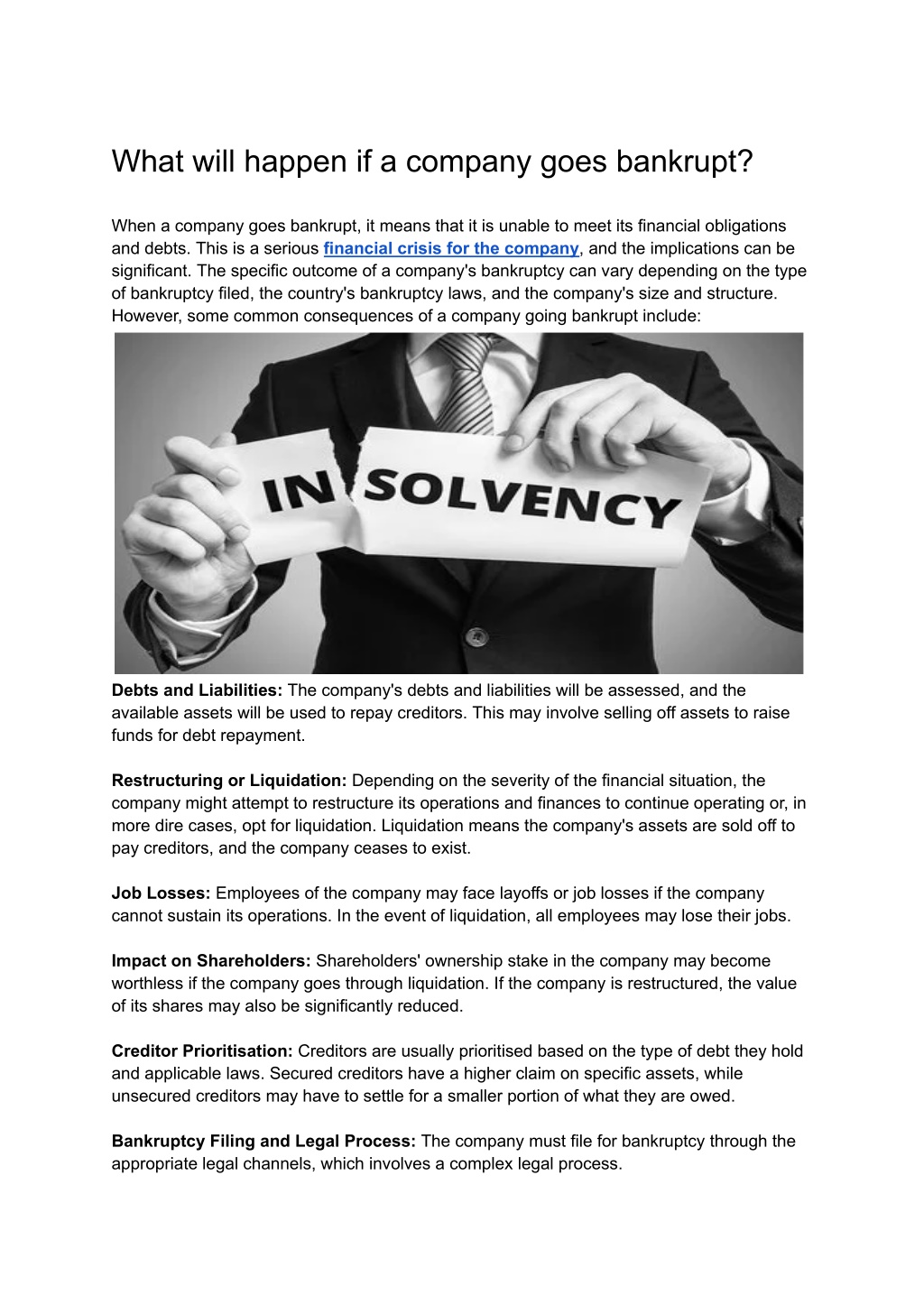If a Company Goes Into Administration, What Happens to Staff Payments and Redundancy? A Guide for Administration Staff
Wiki Article
Business Insolvency Company 7 Preswich Avenue, Leigh, WN7 1RZ 0333 567 1686
Comprehending the Effects of Company Liquidation on Employee Retention and Perks

Effect On Job Safety
In the event of company liquidation, the influence on task safety can be substantial for employees as unpredictability relating to future work occurs. When a business enters into liquidation, staff members deal with the daunting possibility of prospective work loss. This uncertainty can cause enhanced anxiety and anxiousness amongst the labor force, impacting their spirits and efficiency.During the liquidation procedure, staff members may experience a variety of feelings, consisting of aggravation, fear, and temper, as they grapple with the opportunity of joblessness. The absence of clarity bordering the timeline of the liquidation and the fate of their positions can produce a sense of instability within the labor force.
Moreover, staff members may likewise be worried about the condition of their advantages, such as health care protection, retirement plans, and paid pause, during and after the liquidation procedure. The possible loss of these advantages adds an additional layer of complexity to an already tough circumstance for workers.
Changes in Staff Member Benefits

One usual adjustment is the decrease or removal of specific benefits to cut prices and settle arrearages. Company contributions to retired life plans may discontinue, leaving workers to carry the complete obligation of saving for their future. Additionally, medical care advantages might be scaled back, causing greater out-of-pocket expenditures for medical services.
Interaction ends up being extremely important during this period of shift. Employers must be transparent about the adjustments, supplying clear descriptions and support to aid workers browse through the adjustments. Open up dialogue and support can aid ease anxiety and uncertainty amongst the labor force, fostering an extra positive transition experience in spite of the challenging circumstances.
Retention Techniques Post-Liquidation
Complying with the firm liquidation, implementing effective retention techniques is vital to guarding business ability and maintaining stability within the labor force. In times of unpredictability, staff members might really feel distressed concerning their future work safety and security and be more inclined to look for different employment possibility. To alleviate this threat, firms need to concentrate on open interaction, supplying openness concerning the company's circumstance, and supplying assistance to workers throughout the shift duration.
One key retention approach post-liquidation is to focus on employee wellness and morale. Furthermore, supplying job advancement possibilities and upskilling programs can increase staff member motivation and involvement during difficult times.
In addition, establishing a clear career progression course and establishing reasonable goals can provide staff members an orientation and purpose within the business (do employees get paid when company goes into liquidation). By investing in worker growth and proactively involving them in decision-making processes, companies can increase worker retention prices and develop a resistant workforce post-liquidation
Legal Legal Right and Defenses
During the after-effects of company liquidation, it is essential to attend to the lawful civil liberties and defenses available to workers to make sure a reasonable and find more info compliant process. Workers encountering job loss because of liquidation have actually specific legal rights secured by work laws. These legal rights consist of entitlements to overdue incomes, discontinuance wage if appropriate, and accrued holiday or authorized leave payouts. If required to navigate the intricacies of the liquidation procedure., it is critical for staff members to recognize these rights and seek legal advice.Additionally, in cases where a company goes right into liquidation, workers are usually taken into consideration preferential creditors, giving them greater concern in obtaining superior repayments over various other financial institutions. This protection helps focus on clearing up employee claims prior to various other financial responsibilities are satisfied. Additionally, legal safeguards exist to stop unjust terminations throughout liquidation, making sure that discontinuations are performed according to established labor regulations. Recognizing these lawful civil liberties and securities is fundamental for employees to safeguard their rate of interests and look for appropriate choice in the occasion of business liquidation.
Managing Financial Unpredictability
Navigating economic unpredictability can be a difficult obstacle for employees impacted by company liquidation. The abrupt loss of earnings, advantages, and task safety and security can significantly interfere with individuals' monetary stability. Throughout such times, it is vital for staff members to evaluate their existing financial circumstance realistically. Producing a thorough spending plan that prioritizes necessary expenses can help in managing prompt financial requirements. Additionally, exploring readily available federal government assistance programs, such as unemployment insurance or re-training opportunities, can give some relief.It is crucial for workers to remain notified regarding their entitlements, such as severance bundles or superior settlements, to guarantee they receive what they are owed. By proactively dealing Visit Your URL with financial challenges, workers can browse through the uncertainty caused by company liquidation with better strength and readiness.
Conclusion
Finally, firm liquidation can have substantial effects on staff member task safety and security, benefits, and total well-being. It is vital for companies to implement retention strategies and supply support to staff members throughout this unsure go to these guys time. Understanding lawful rights and securities can help reduce the influence of liquidation on employees. Managing economic unpredictability needs an aggressive strategy and interaction from both workers and employers to browse with the difficulties effectively.When a company deals with liquidation, the fate of its staff members hangs in the balance, raising critical questions about task security, advantages, and long-lasting stability. The influence of company liquidation on staff member retention and benefits is a multifaceted issue that requires a more detailed exam to recognize the full range of its consequences.
Browsing financial unpredictability can be a daunting difficulty for staff members affected by firm liquidation. By proactively resolving economic challenges, employees can browse via the unpredictability caused by business liquidation with higher durability and preparedness.

Report this wiki page